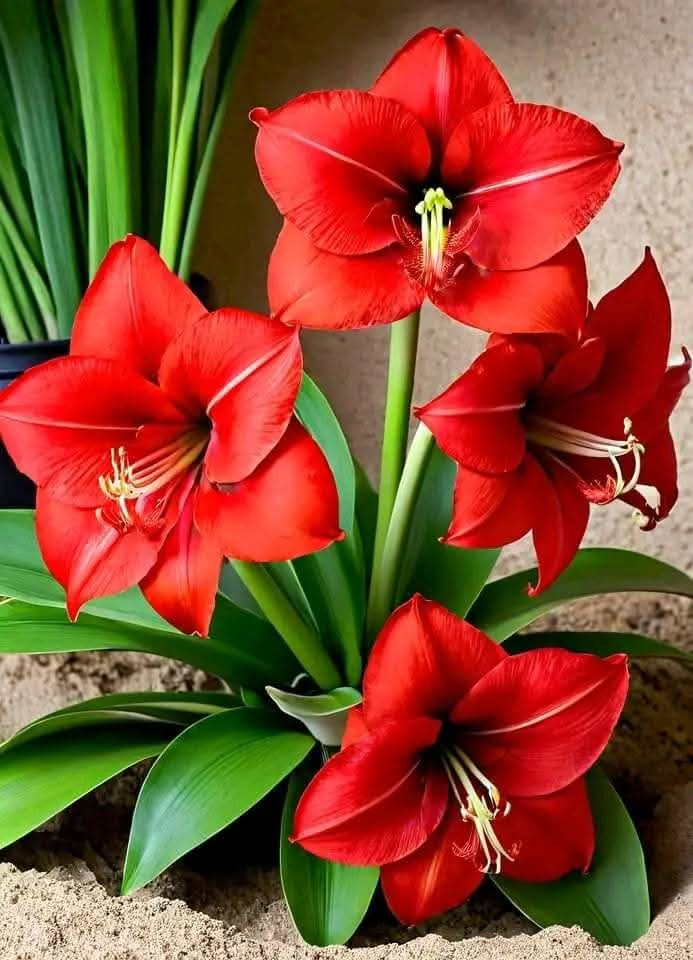Amaryllis (Hippeastrum) is a stunning, vibrant flowering plant known for its large, trumpet-shaped blooms that come in a variety of colors, including red, pink, white, and orange. These flowers often feature striking patterns that make them even more captivating. With their long, slender green leaves and bold flowers, Amaryllis can brighten up any indoor space or garden bed. Easy to grow with the right care, Amaryllis is the perfect plant to add elegance and vibrant color to your home.
Light: Providing the Right Amount of Brightness
Amaryllis plants thrive in bright, indirect light. They should be placed in a location where they receive ample light, but not direct sunlight, which could scorch their leaves or cause the flowers to wilt prematurely. If growing indoors, a windowsill with sheer curtains is an ideal spot. Amaryllis can also grow well under fluorescent lights if placed in a location with moderate light exposure.
When grown outdoors in warmer climates, Amaryllis enjoys being in a partially shaded area where it can get some sun without being exposed to the harsh midday heat.
Water: Moist, Well-Drained Soil
One of the keys to successfully growing Amaryllis is keeping the soil consistently moist but well-drained. This prevents the bulb from sitting in water, which could cause it to rot. After planting, water the soil thoroughly and maintain a consistent level of moisture during the growing season.
Once the plant finishes flowering, you should reduce watering, allowing the soil to dry out a little between waterings until new growth appears. This period of dormancy helps the bulb rest and regenerate for the next bloom cycle. Always check the soil’s moisture before watering, as overwatering can be harmful to the plant.
Soil: The Best Growing Medium
Amaryllis prefers a well-draining, rich mix for optimal growth. Use a high-quality potting mix designed for container plants or a blend that includes peat, perlite, and sand to promote good drainage. Avoid heavy, clay-based soil, as it can hold too much moisture and cause the bulb to rot.
If you’re growing Amaryllis in a garden bed, amend the soil with organic matter to ensure proper drainage. Well-draining soil allows the bulb to grow strong roots while preventing water from accumulating around the base of the plant.
Temperature: The Ideal Range for Healthy Growth
Amaryllis plants flourish in temperatures between 65-75°F (18-24°C), which is a comfortable range for both indoor and outdoor growth. If growing indoors, keep the plant in a location away from drafts and direct sources of heat or cold, such as near air conditioners, radiators, or windows that frequently open. Outdoors, Amaryllis can tolerate mild temperatures but should be protected from frost.
During their blooming season, they appreciate a steady temperature to ensure healthy flower development. Once the blooms fade, Amaryllis can tolerate slightly cooler temperatures during its dormancy period.
Humidity: Moderate Levels for Vibrant Growth
While Amaryllis does not require extremely high humidity, it thrives in moderate humidity levels. Ideal humidity is around 50-60%, which is typically found in most indoor environments. If you live in a particularly dry area, you can increase humidity by placing the plant on a humidity tray filled with water and pebbles or by using a room humidifier.
If growing Amaryllis outdoors, ensure that the plant is sheltered from wind and has enough moisture in the air to keep the leaves from drying out. However, it can tolerate a range of humidity levels as long as it is not exposed to prolonged periods of extreme dryness.
Fertilizer: Keeping Your Amaryllis Nourished
Fertilizing Amaryllis during the growing season helps promote healthy growth and beautiful flowers. Use a balanced fertilizer, such as a 10-10-10 formula, and apply it every 2-4 weeks throughout the active growing period. This provides the necessary nutrients for strong roots, vibrant blooms, and overall plant health.
When applying fertilizer, follow the manufacturer’s instructions to avoid over-fertilizing, as this can lead to weak growth or damage to the roots. During the dormancy period, stop fertilizing the plant, allowing it to rest and regenerate for the next bloom cycle.
A Beautiful and Easy-to-Grow Addition
Amaryllis is not only an easy-to-grow plant, but it also brings a touch of elegance and color to any space. Whether you’re growing it indoors in a decorative pot or planting it in your garden, this hardy plant can bloom year after year with the right care.
Its large, showy flowers create a stunning display, and its graceful green leaves provide a lovely contrast. Amaryllis is an excellent choice for adding a pop of color to your home or garden, especially during the colder months when other plants may not be flowering.
Conclusion: A Rewarding Plant to Grow
Amaryllis is a stunning, vibrant plant that is relatively easy to care for, making it an ideal addition to any home or garden. By providing the right light, water, soil, and temperature, you can enjoy the beauty of its large, trumpet-shaped blooms and lush green foliage. With a little attention and care, your Amaryllis will reward you with stunning flowers that bring joy and elegance to your space for years to come.
Whether you’re a seasoned gardener or a beginner, Amaryllis is a rewarding plant to grow, offering long-lasting beauty and a vibrant touch of color in every season. Happy gardening! 🌸
More Articles You Might Like
-
Texas Toast Sloppy Joes: The Crunchy, Cheesy Upgrade You Didn’t Know You Needed
There’s something timeless about sloppy joes. For generations, this saucy, savory, and slightly sweet ground beef sandwich has been a go-to comfort food in American kitchens. It’s quick, filling, and family-friendly—perfect for busy weeknights. But what if we told you there’s a way to take this classic dish up a notch? Enter the Texas Toast…
-
Classic Pig Pickin’ Cake
When it comes to Southern desserts, few sweets shine as brightly as the Classic Pig Pickin’ Cake. This nostalgic cake, sometimes called a “Mandarin Orange Cake,” has roots deep in Southern tradition. It gets its playful name from its frequent appearance at pig pickin’s—Southern-style barbecue gatherings where communities come together to enjoy slow-cooked pork, sides,…
-
Lemon Garlic Butter Chicken with Creamy Parmesan Pasta
There’s something irresistible about the combination of tender, golden-browned chicken paired with a creamy pasta coated in Parmesan cheese. Add the brightness of lemon, the depth of garlic, and the richness of butter, and you have a recipe that feels indulgent yet approachable enough for a weeknight dinner. Lemon Garlic Butter Chicken with Creamy Parmesan…



